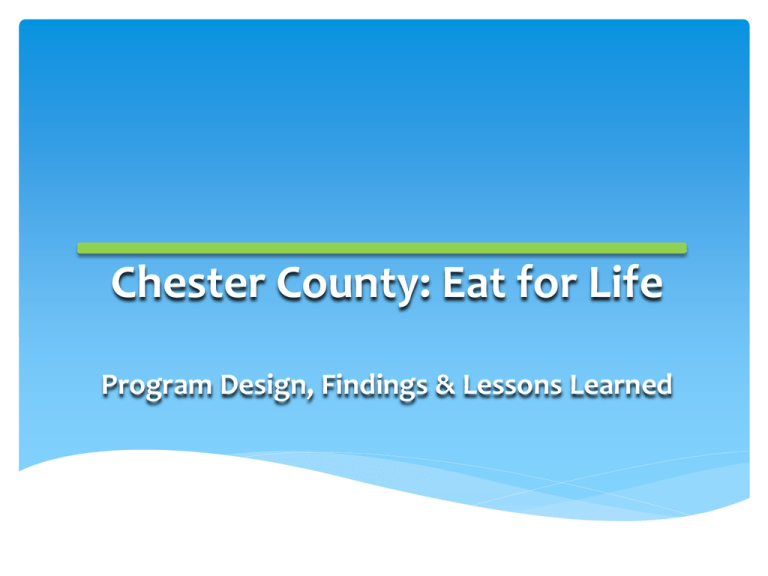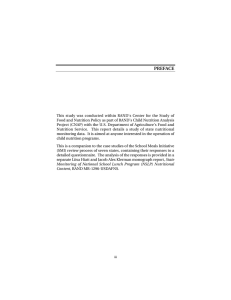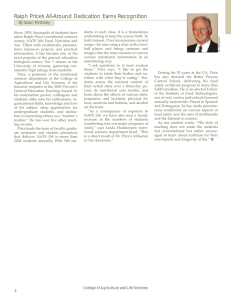Chester County: Eat for Life Program Design, Findings & Lessons Learned
advertisement

Chester County: Eat for Life Program Design, Findings & Lessons Learned MISSION An effective nutritional health literacy system addressing each participant’s specific health needs, irrespective of literacy level. What we knew According to the American Medical Association, the determinants of health and wellness are: 20% related to genetics; 20% related to the environment; 50% related to proper nutrition and physical activity; 10% related to accessibility of health care. Nutrition is the insidious barrier to being healthy! ERASE the BARRIER by…. Developing A UNIVERSAL CURRICULUM Curriculum mandates for effectiveness with all populations… Everyday applications; Plain language; Offer immediate value for each member of the family; Address age and gender; Concrete and concise action steps; Generic and universal to all literacy levels; Adaptive to yet independent of culture; Offer repetitive learning opportunities; Incorporate self-pace learning; Linked to prior experience; Translatable; Require no additional financial resources. Curriculum Goals and Objectives EQUIP PARTICIPANTS WITH SKILLS TO: Bridge the scientific gap; Gather, analyze and use nutritional/health information; Manage resources; Work within the big picture; Work together; Provide leadership; Guide and support others; Curriculum Goals and Objectives EQUIP PARTICIPANTS WITH SKILLS TO: Develop and express a sense of self; Respect others and value diversity; Exercise rights and responsibilities; Create and pursue vision and goals; Use technology and other tools to accomplish goals; Keep pace with change. What we had to do... Use adult teaching principles to guide the instruction; Learning styles (presented in many forms): Visual; Aural; Verbal; Tactile; Social; Solitary. Basic literacy skill development: Prose skills – understanding written text; Document skills – understanding short forms or charts; Quantitative skills – understanding information displayed visually in graphs or in numeric form using whole numbers, fractions, decimals, percentages or time units. Additionally, to be effective in the context of nutrition….. We needed to focus constantly on the predisposing, enabling and reinforcing factors to proper nutrition so that participants, in any setting (e.g. grocery store, restaurants, church, meetings, home, ) would have a: Mindset to take an active role in personal and family nutrition; Toolset to understand nutritional options; Skill set to make shared decisions. EXAMPLE SUGAR Training Module Health Literacy Information Model Results/Findings Post-Surveys 51% are using recipes from the Eat for Life cookbook; 100% are changing recipes because of the class; 100% are deleting family recipes because of the class; 100% are reading food labels more carefully; 89% increased fruit and vegetable intake to 5 or more servings daily; 100% increased daily water intake; 84% reduced the amount of fats/salt/added sugars/cholesterol in their diets. Results/Findings Post-Surveys: 26% lost weight; 40% maintained current weight. Results/Findings Days limited due to medical problems during last 30 days: Pre-Average 21 days; Post-Average 5 days. Results/Findings Post-Surveys 93% demonstrated increased understanding of the relationship between healthy behaviors (e.g., proper nutrition, adequate physical activity, not smoking, and minimal alcohol consumption) and reducing the risk of developing heart disease, certain types of cancer, and adult diabetes; 98% felt the program improved their ability to make better decisions about their health. Other Outcomes Creating a plain language movement in nutrition; Creating “knowledgeable dietary planners” who are taking an active role in their family’s health and wellness; Creating “lay nutritionists” and self-help action groups who are communicating nutritional knowledge throughout their communities and social, civic, and religious memberships. Lessons Learned We can empower individuals with the knowledge to make good decisions for their own health in a timely manner when: 1. They first recognize that personal and family health is not the sole responsibility of our health care professionals; 2. They are connected with the most current and motivational health information; 3. They are given standards of reference; 4. They are given and able to learn practical tools to make simple and incremental dietary/lifestyle changes within the context of their daily lives; 5. They recognize that there is no need for additional financial resources. Lessons Learned One can be health literate in one language and not in another; One can be literate in all other aspects and still have low health literacy skills; Low nutritional skills exist among the educated and the uneducated; Low nutritional skills exist among the rich and the poor; Regardless of our many stations in life, nutritional skills are the skills we seldom learn, but so desperately need! Lessons Learned If we addressed our HEALTH care … doctors and other health professionals could focus on our SICK care! FUNDED BY: Chester County Literacy Council 109 Ella Street Chester, SC 29706 803.581.1960 803.482.2525 dfedrick1207@truvista.net




